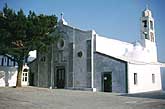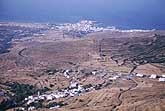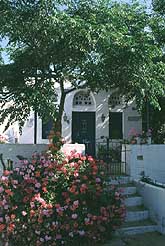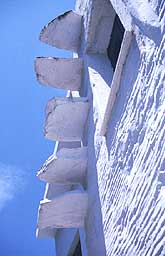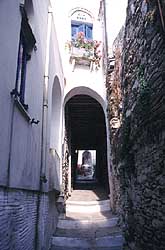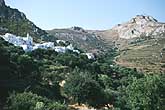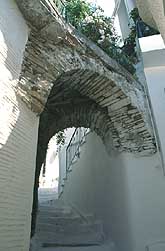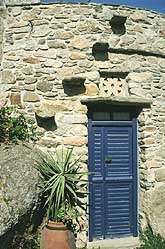Historically, the island has been called by many names, including Ophiousa as it had many snakes, and Ydrousa because it had plenty of water.
It is not known for certain who the first inhabitants of the islands were, but eventually the island was settled by the Ionians. The earliest traces of settlement date from the Mycenean period. The area around Xobourgo was the centre of life on the island from the Geometric period down to the 5th century BC and then again in the middle ages.
Xobourgo is an easily defended mountain as the summit can only be approached from one side. At the foot of the mountain a walled city has been excavated and many Geometric period tombs have been unearthed.
It was in the 5th century BC that the site of the main town was moved to its present site. During the classical period the Temple of Poseidon and Amphitrite became a major focus. The site was excavated at the beginning of the 20th century. Because of its worship of Poseidon, Tinos became an important religious centre and a stopping off point on the way to Delos.
The fame of the temple spread outside Greece during the 3rd century BC when the temple was extended and Amphitrite, the wife of Poseidon, also began to be worshipped.
The temple continued in operation until the 4th century AD when, with the arrival of Christianity, it was destroyed.
Dionysos was also worshipped on the island and his temple stood on the site which is now occupied by the Evangelistria cathedral.
As would be expected, many of the coins from the 4th and 3rd century BC show Poseidon or a trident or Poseidon holding a trident. The name Tinos also appears on some coins.
A Tinian was to play a key role in the Battle of Salamis against the Persians. Tinos had already submitted to the Persians but a Tinian naval commander called Panaitios Sosimenous joined the Greeks and brought with him news of Persian plans to surround the Greek fleet at Salamis.
The Tinians also fought against the Persians at Plataea. Tinos became
part of the Delian League and later gained autonomous status. Subsequently
it was ruled by Philip of Macedon and various members of the Ptolemy
family in Egypt before finally becoming part of the Roman Empire in
the 2nd century BC.
THE VENETIANS AND THE TURKS
After the fall of Byzantine to the Franks in 1204, the Cyclades fell into the hands of the Venetians. In 1207, the Ghizzi dynasty took control of Tinos and ruled the island until 1390. Although the links with Venice were very loose, the last Ghizzi to rule over Tinos left it to the Venential Republic in his will. In 1390 the Venetians agreed to direct rule over the island, which remained under Venetian rule until 1715.
The Turks proved unable to conquer the island which remained independent of Turkish rule while the whole of Greece became part of the Ottoman empire. This unique position allowed the island to flourish. A wide range of agricultural products were grown on the island which also specialised in the weaving of silk and linen fabrics and knitted wear.
The transfer of theisland from Venetian to Ottoman rule was accompanied by many religious and economic privileges. The island was effectively self-governing and the only permanent Turkish residents on the island were the Governor and the Judge.
While many Tiniots moved to other parts of the Ottoman Empire there was also an influx of people onto the island because, compared with the rest of Greece, living conditions were so much more favourable there.
During this period commercial, industrial and shipping activity developed rapidly. The island became the economic capital of the Cyclades and the population rose to between 24,000 and 28,000 people. Several European countries including France, Russia and England had diplomatic representatives on the island.
|
History
|
|
by Ian Swindale
Photos © Ian Swindale
Copyright: Hellenic Electronic Center
Back to Cyclades Islands

